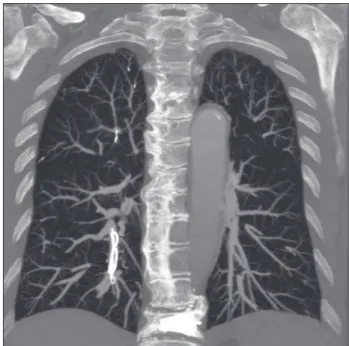516
IMAGE IN MEDICINE
Rev Assoc Med Bras 2012; 58(5):516
Unexpected finding in computed tomographic pulmonary angiography
THIAGO HORTA SOARES1, MARCOSDE BASTOS2, WANDERVAL MOREIRA3, SUELY MEIRELES REZENDE4
1 Hospital Mater Dei; Department of Internal Medicine, Grupo de Estudo da Hemostasia e Trombose (GETHe), Faculty of Medicine, Universidade Federal de Minas Gerais (UFMG),
Belo Horizonte, MG, Brazil
2 Instituto de Previdência do Estado de Minas Gerais, Department of Internal Medicine, GETHe, Faculty of Medicine, UFMG, Belo Horizonte, MG, Brazil 3 Hospital Mater Dei, Belo Horizonte, MG, Brazil
4 Department of Internal Medicine, GETHe, Faculty of Medicine, UFMG, Belo Horizonte, MG, Brazil
Study conducted at Hospital Mater Dei, Belo Horizonte, MG, Brazil
Correspondence to: Thiago Horta Soares – Hospital Mater Dei, Departamento de Clínica Médica, Rua Goncalves Dias, 2700, Belo Horizonte, MG, Brazil, CEP: 30140-092, Phone/Fax: +55 31 3339-9242 – hortasoares@gmail.com
©2012 Elsevier Editora Ltda. All rights reserved.
A 78-year-old woman was admitted to the hospital with nausea and abdominal pain. She had a history of lum-bar fracture secondary to corticosteroid use and under-went an uneventful vertebroplasty at L1-L2 three months before admission. Laboratory tests and an abdominal computerized tomography showed acute pancreatitis.
hree days later, she complained of dyspnea and had a transient thoracic pain. No hemodynamic instability was detected. A thorax computed angiotomography was performed, which showed dense intravascular masses located inside the arteries for the right superior, infe-rior, and middle lobes, suggestive of pulmonary cement emboli (PCE) (Figure 1). Respiratory symptoms disap-peared and no relation was found between PCE and ac-tual symptoms. he patient was submitted to a cholecys-tectomy, and recovered well.
PCE is a possible systemic complication associated
with vertebroplasty or kyphoplasty1. he reported
preva-lence (4.6% to 23%) may be an underestimation, as PCE
Figure 1 – Thorax computed angiotomography showing dense intravascular masses.
screening is not routinely undertaken2-3.Cement emboli
may reach the pulmonary circulation through the
peri-vertebral venous system, the azygos and cava veins1. Its
clinical presentation varies from an asymptomatic
pic-ture to sudden death1-3. he management of PCE is not
well established. No treatment is indicated in asymp-tomatic patients, but surgical removal, heparinization, or anticoagulation with vitamin K antagonists may be considered4.
It is suggested that PCE may be prevented by appro-priate patient selection for surgery, improved surgical techniques, and good image screening by luoroscopy during the procedure1-4.
REFERENCES
1. Lee IJ, Choi AL, Yie MI, Yoon JY, Jeon EY, Koh SH, et al. CT evaluation of local leakage of bone cement ater percutaneus kyphoplaty and vertebroplasty. Acta Radiol. 2010;51(6):649-54.
2. Kim YJ, Lee JW, Park KW, Yeom js, Jeong HS, Park JM, et al. Pulmonary ce-ment embolism ater percutaneous vertebroplasty in osteoporotic vertebral compression fractures: incidence, characteristics, and risk factors. Radiology. 2009;251(1):250-9.
